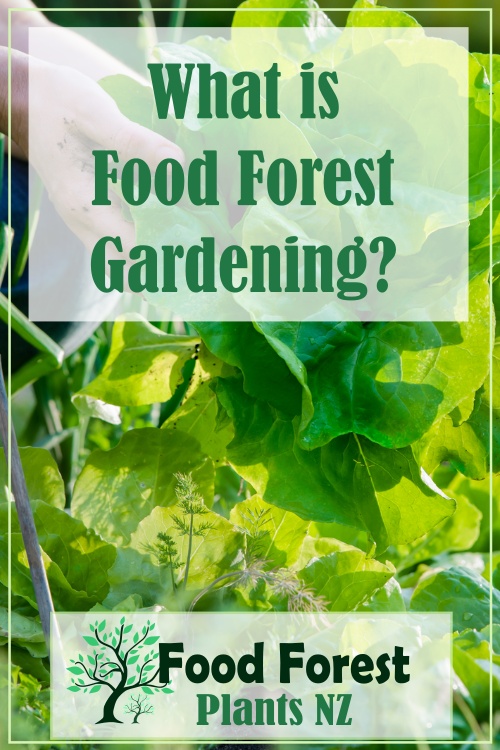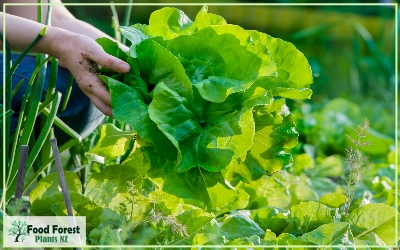Forest gardening, also known as food forests or permaculture gardens are becoming more and more popular within the New Zealand context.
There are a few popularly known large forest gardens, and so many more in peoples urban back yards.
If you have found your way here, I presume that you are interested in finding out more about forest gardening and how it can benefit you, your family, your community and the planet.
What is forest gardening?
When you take a walk through some of New Zealand’s beautiful native bush and forests you will understand what we are trying to emulate with a forest garden.
If you examine any naturally growing bush closer you will find that the forest is made up of different layers of plants.
On the ground you find composting leaves, peaty soil, mushrooms, moss and groundcovers.
In the middle at chest level you see bushes and shrubs.
Look up and above your head you see the canopy of taller trees and vines and epiphytes growing amongst them.
Together these layers make up a forest garden and this is the nature-inspired concept to follow when you are planting a food forest.
Food forests are a great way to grow a large variety of food in a self sustaining low input way, by harnessing nature’s natural processes.
Where can you grow forest garden?
This type of permaculture food system can be incorporated into any sized garden and once established can be incredibly productive.
When you’re looking to set up at home, location is important to determine the size of the forest you’re to create, and also it helps if you can work with existing planting as trees do take some time to establish.
Research is the key to creating a successful food forest, to help you select fruit and berries, ground cover and canopy trees that are suited to the size of your garden/the space you have dedicated.
Heirloom and heritage varieties are usually selected for projects like this due do their proven record to survive well.
The idea behind the food forest is to work with nature, with minimal intervention – so it is important to select plants that are naturally suited to your site and climatic conditions (while of course being things you like to eat!).
This means in New Zealand that most of us cannot copy the American food forests of Florida and expect to be able to grow bananas, pineapple or many of the other plants that you see mentioned!
What can you use a forest garden for?
Imagine being able to walk outside your door and pick a plum, collect some berries, pluck some mushrooms or collect some plants to naturally dye some clothes.
Food forests also provide shade and privacy to your garden.
A food forest creates a habitat for local wildlife, pest control, pollination, therefore providing healthy food for humans and also providing wildlife viewing opportunities.
Food forests can also provide other products than food such as fibres, wood for heating, materials for trellis, and help reduce water usage.
The following are the functions we would like your forest garden to serve for us:
- Regeneration of the land
- Eggs, meat, fruit, nuts, herbs, mushrooms
- Grow nourishing food
- Provide medicinal herbs
- High output/low input over the long term
- Seed production and other propagation materials for our nursery
- Firewood
- Inspiration for the community and our family
- Carbon sink for the environment
- Source of charcoal/biochar
What is a food forest made up of?
Food forests are a selection of plants that feed us, the ecosystem, and contribute to an improved environment.
A forest comprises of up to seven layers of vegetation:
1. Tall canopy trees
These are the larger fruit and nut trees
2. Lower layer canopy
These are a layer of dwarf fruit trees. If your area is small, this can be your top layer and you simply miss out the taller trees.
3. Shrubs
This is where many nitrogen fixers and berries fit. You need to choose ones that don’t mind living in the semi shade.
4. Herbaceous layer
This is where edible herbs, leafy plants.
5. Ground cover
Strawberries are my favourite ground cover! But there are many options you can mix and match from.
6. Vines
You can also integrate a vertical layer with climbers, and vines.
7. Root crops
Some herbs like horse radish and other plants like yacon, sunchoke and carrots all fill this role nicely.
What is involved in maintaining a forest garden?
In terms of ongoing care you will find that the garden will develop its own natural balance of change and establishment.
The garden will produce its own ecosystem, with birds, insects, fungi and the like all working together. This can happen very quickly with the right management.
A forest garden is a long term project and the theory is that what is produced on the land stays on the land, to help keep the fertility in balance and to help minimise in put requirements.
There will be some trial and error along the way as you figure out what is growing well in the environment you have created, and what isn’t doing so well.
Why should you consider growing a forest garden?
We are all familiar with our beautiful surrounding native forests. They are lush environments, dominated by trees but with all sorts of plants filling every possible space in between.
Forests are places full of life, providing a richness of biodiversity and do not need humans to thrive, and an established food forest is no exception.
There is growing evidence that the Amazon jungle is in fact a planned food forest garden that as been left to re-wild after the native people were wiped out with small pox – but that is a story for another day.
Many of the native American forests were also planted, maintained and certain plants encouraged to grow by the Native American people to provide food year-round.
By growing a forest garden you can obtain a highly efficient, highly productive, sustainable way of growing food.
Food forests are probably the world’s oldest form of land use and most resilient agroecosystem.
Using permaculture principals to work with and mimic nature, we are are guiding natural processes and using human intent to get what we need.
One of the key principals of permaculture is that everything should be multi purpose. By selecting practical plants that serve multiple functions we build diversity in all layers of the forest garden.
By using our human knowledge and planning we can encourage and speed up the growth and development of the forest leading to beautiful, abundant and nutritious habitats for us and other wild life.
Next step: Designing a Forest Garden


